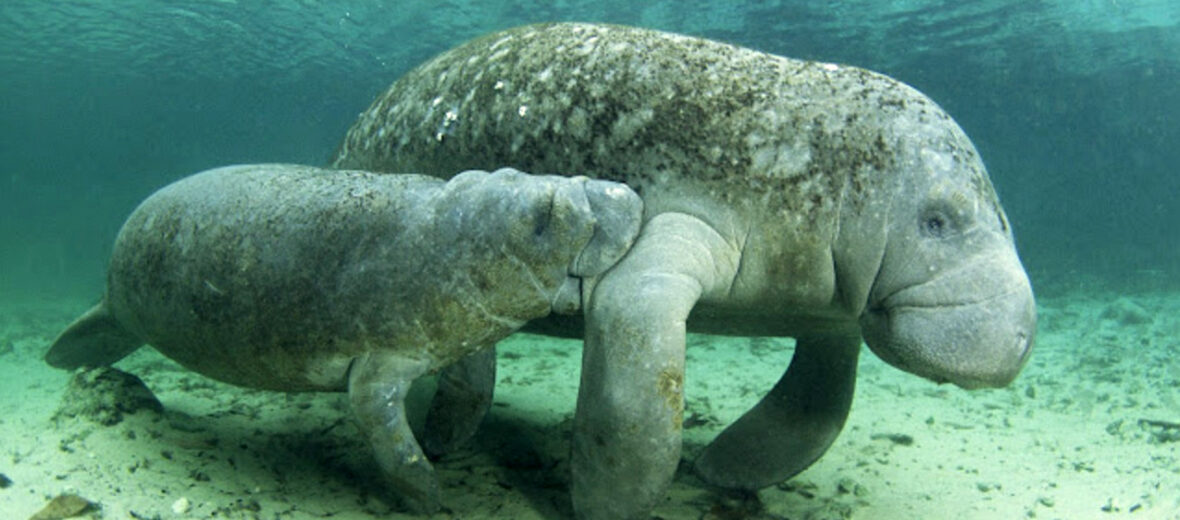
The African manatee, aka West African manatee, can still be spotted along the western coast of Africa (from Senegal to Angola) and into certain fresh water bodies. They favor coastal estuaries, lakes, oceans, rivers, reservoirs, lagoons, bays along the coast, shallower coastal flats, and also mangrove creeks rich with seagrass. Unfortunately, these magnificent beasts suffer the threats of habitat loss and destruction at the hands of residential and commercial development, agriculture, dams, and mining; accidental interference with shipping lanes (which results in vehicle strike – being hit by ships and propellers); human recreational activities; logging; wood harvesting; pollution; and climate change (resulting in droughts, water temperature changes, and flooding that causes runoff of hazardous agricultural and other chemicals.
First the Stats…
Scientific name: Trichechus senegalensis
Weight: Up to 1,200 lbs.
Length: Up to 15 feet
Lifespan: Up to 30 years
Now on to the Facts!
1.) African manatees are listed as Vulnerable by the IUCN with an estimated population of only 10,000+/-.
2.) Their numbers are also decreasing.
3.) A group of manatees is called a herd.
4.) African manatees are nocturnal (active at night).
5.) During the daytime, these creatures rest in shallow water topping 6.56 feet deep.
But wait, there’s more on the African manatee!
6.) In June and July, in Sierra Leone, these critters will migrate upstream to escape the flooding.
7.) They can be found in herds of up to 6 individuals.
Did you know…?
The max speed of these critters is up to 20 mph. But that’s just when frightened. Normally, they swim at speeds of up to 5 mph.
8.) These manatees are social and spend their evenings grazing and bonding via touch, vocalizations, and smell.
9.) Aquatic vegetation, clams, mollusks, and fish are all on the menu. However, those that primarily dwell in rivers graze on overhanging plants along the river banks. Those that live in estuaries will tend to graze solely on mangrove plants.
10.) The African manatee is polygynous (multiple males mate with a single female).
But wait, there’s still more on the African manatee!
11.) Mating season lasts year round.
12.) When multiple males are interested in a female, they will tend to fight each other by shoving and pushing each other to win breeding rights.
Did you know…?
In some countries, like Cameroon & Nigeria, these manatees are sold to aquariums, zoos, online as pets, and they are sometimes also shipped internationally.
13.) Females undergo up to a 13 month gestation (pregnancy) that yields a single calf.
14.) The calf is born precocial (self sufficient).
15.) Another threat they face is that of poaching. Poachers hunt and butcher African manatees for their bones, meat, oil, and skin, which fetch a heavy price on the black market.
But wait, there’s still a little more on the African manatee!
16.) The primary difference between African and American manatees is that African manatees have white markings on their abdomen.
17.) They utilize their forelimbs in swimming and in bringing food to their mouths.
Did you know…?
African manatees can eat up to 9% of their body weight in plants each day.
18.) Upon birth, these manatees possess 2 vestigial incisors on each jaw. These are lost as they age.
19.) When their molars fall out, new ones replace the lost teeth.
20.) According to legend, Maame Water, a character in many coastal legends, is a goddess of the sea as well as a symbol of wealth and beauty. This character is depicted by an African manatee.
Now a Short African Manatee Video!
This videos talks about manatees in general.
Be sure to share & comment below! Also, check out the Critter Science YouTube channel. Videos added regularly!
Want to suggest a critter for me to write about? Let me know here.
Some source material acquired from: Wikipedia & IUCN
Photo credit: Creative Commons



